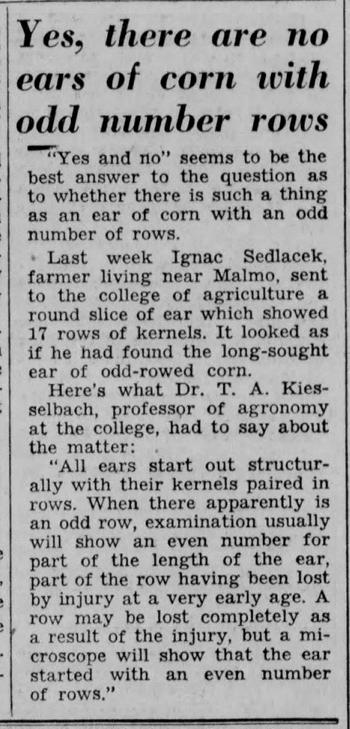Corn with odd number of rows

Hood County News-Tablet - Mar 17, 1966
Ears of corn almost always have an even number of rows. Foodreference.com explains the science:
Row number is always an even number because corn spikelets are borne in pairs, and each spikelet produces two florets: one fertile and one sterile. Stress at a particular stage in development could theoretically produce an ear with an odd number of rows - but I believe if you looked under a microscope, you would find an unseen row that failed to develop fully.
When corn ears are found that have an odd number of rows, that's considered weird enough to make news. For instance, cases of odd-rowed corn surfaced in 1930 (found by Everett Kelderhouse of Collins, Iowa), 1941 (found by Ignac Sedlacek of Malmo, Nebraska), and 1949 (found by Alfred Kohnert of Calamus, Iowa).

Lincoln Evening Journal - Oct 24, 1941

Carrol Daily Times - Sep 14, 1949
In popular culture, finding odd-rowed corn was sometimes used to make impossible-to-come-true promises. For instance, slaves might be told that they could have their freedom if they could find an ear of corn with an odd number of rows. But in the example below, recounted in Atheism and Arithemetic, Or, Mathematical Law in Nature (1885), one slave supposedly devised a way to find some odd-rowed corn:
A story is told of a slave who, on being promised his freedom if he would find an ear of corn having an odd number of rows of kernels, went into the corn-field and carefully opening the husks on a number of ears, deftly cut out a row of kernels from each, closing up the husks over the ears again. The corn grew and ripened, closing up in its growth the vacant spaces, and when it was gathered he found an ear with an odd number of rows, and presented it and claimed the promised boon!
Comments
Commenting is not available in this channel entry.

Category: Food | Vegetables